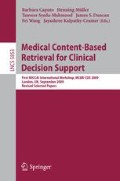Abstract
Our goal is to propose a methodology to integrate clinical, cognitive, genetic and neuroimaging results, a disparate assembly of categorical, ordinal, and numerical data, within the context of Alzheimer’s disease (AD) research. We describe a knowledge-based, explicit decision model for the discrimination of AD subjects from normal controls (CTRL) based on a recent approach for diagnostic criteria for AD. We proceed by (a) creating a set of rules for each datum source; (b) integrating these disparate data into an information feature in the form of a binary string; and (c) using a machine learning approach based on the Hamming distance as an information similarity measure for the discrimination of probable AD from CTRL. When tested on 249 subjects from the multi-centric Alzheimer’s Disease Neuroimaging Initiative study, we reach up to 99.8% discriminative accuracy using a 9-bit information string in a series of 10-fold validation experiments. We expect this versatile approach to become useful in the identification of specific and sensitive phenotypes from large amounts of disparate data.
Access this chapter
Tax calculation will be finalised at checkout
Purchases are for personal use only
Preview
Unable to display preview. Download preview PDF.
References
Weiner, M., et al.: The Use of MRI and PET for Clinical Diagnosis of Dementia and Investigation of Cognitive Impairment: A Consensus Report. 2005. Alzheimer’s Association (2005)
Lim, A., et al.: Clinico-neuropathological correlation of Alzheimer’s disease in a community-based case series. J. Am. Geriatr. Soc. 47(5), 564–569 (1999)
Dubois, B., et al.: Research criteria for the diagnosis of Alzheimer’s disease: revising the NINCDS-ADRDA criteria. Lancet Neurol. 6(8), 734–746 (2007)
von Borczyskowski, D., et al.: Evaluation of a new expert system for fully automated detection of the Alzheimer’s dementia pattern in FDG PET. Nucl. Med. Commun. 27(9), 739–743 (2006)
Blennow, K., de Leon, M.J., Zetterberg, H.: Alzheimer’s disease. Lancet 368(9533), 387–403 (2006)
Beinhoff, U., et al.: Gender-specificities in Alzheimer’s disease and mildcognitive impairment. J. Neurol. 255(1), 117–122 (2008)
Koepsell, T.D., et al.: Education, cognitive function, and severity of neuropathology in Alzheimer disease. Neurology 70(19 Pt 2), 1732–1739 (2008)
Hamming, R.W.: Error Detecting and Error Correcting Codes. Bell System Technical Journal 26(2), 147–160 (1950)
Folstein, M.F., Folstein, S.E., McHugh, P.R.: Mini-mental state. A practical method for grading the cognitive state of patients for the clinician. J. Psychiatr. Res. 12(3), 189–198 (1975)
Rosen, W.G., Mohs, R.C., Davis, K.L.: A new rating scale for Alzheimer’ s disease. Am. J. Psychiatry 141(11), 1356–1364 (1984)
Wechsler, D.: WMS-R Wechsler Memory Scale - Revised Manual. The Psychological Corporation, Harcourt Brace Jovanovich, Inc., New York (1987)
Jack, C.R.: The Alzheimer’s Disease Neuroimaging Initiative (ADNI): MRI methods. J. Magn. Reson. Imaging 27(4), 685–691 (2008)
Hsu, Y.Y., et al.: Comparison of automated and manual MRI volumetry of hippocampus in normal aging and dementia. J. Magn. Reson. Imaging 16(3), 305–310 (2002)
Ohm, T.G., et al.: Apolipoprotein E isoforms and the development of low and high Braak stages of Alzheimer’s disease-related lesions. Acta Neuropathol. 98(3), 273–280 (1999)
Author information
Authors and Affiliations
Editor information
Editors and Affiliations
Rights and permissions
Copyright information
© 2010 Springer-Verlag Berlin Heidelberg
About this paper
Cite this paper
Duchesne, S., Crépeault, B., Hudon, C. (2010). Knowledge-Based Discrimination in Alzheimer’s Disease. In: Caputo, B., Müller, H., Syeda-Mahmood, T., Duncan, J.S., Wang, F., Kalpathy-Cramer, J. (eds) Medical Content-Based Retrieval for Clinical Decision Support. MCBR-CDS 2009. Lecture Notes in Computer Science, vol 5853. Springer, Berlin, Heidelberg. https://doi.org/10.1007/978-3-642-11769-5_9
Download citation
DOI: https://doi.org/10.1007/978-3-642-11769-5_9
Publisher Name: Springer, Berlin, Heidelberg
Print ISBN: 978-3-642-11768-8
Online ISBN: 978-3-642-11769-5
eBook Packages: Computer ScienceComputer Science (R0)

